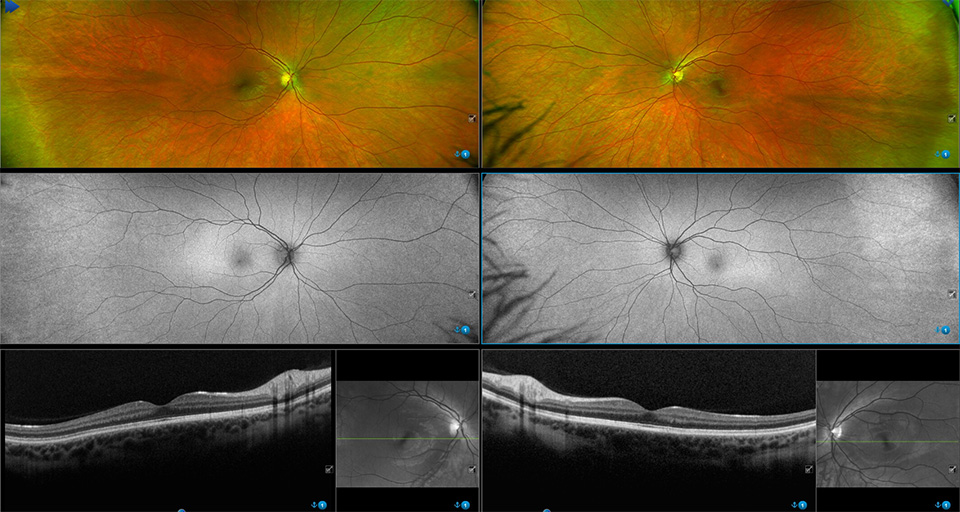- OT
- Life in practice
- Practitioner stories
- I could not live without…the Optos Monaco
I could not live without…
The Optos Monaco
Optometrist and owner of Pilbeam Opticians, Jonathan Pilbeam, discusses the benefits that the Monaco device brings

Jonathan Pilbeam
14 April 2019
For me in practice, the Optos Monaco is an exceptional device. My wife would support my view on this, but perhaps with one minor reservation that I’ll explain later.
Being first
Our practice was one of the first in the world to install the original ultra-widefield laser ophthalmoscopes that were developed by Optos. We took delivery of one of these original devices in 2000 and overnight it revolutionised the way we examined our patients. For the first time, in one click, we were able to view a full 200-degree image of the retina. This was fascinating for optometrists, but it also created a real ‘wow’ factor for our patients.
We were also able to see, in great detail, degenerative and physiological features of the peripheral retina. There was a lot to learn. We had tremendous support from Optos, who provided us with publications that helped us in our interpretation of the images and linked us with a retinal specialist who provided us with a second opinion on newly-discovered and ambiguous retinal lesions.
Over the years, my confidence grew in interpreting these images and my patients began asking for an optomap before I had even suggested it – they could clearly see the benefits of the enhanced patient care we were offering.
On completing my Minor Eye Conditions Service (MECS) qualification, the local GP practice began to appreciate the advantage of ultra-widefield retinal imaging and became keen advocates of the technology – cementing an excellent professional relationship with our practice.
With the regular flashes and floaters referrals, we follow the College of Optometrists’ guidelines with pupil dilation and a slit lamp examination with a hand-held lens performed. However, we always finish with an optomap image, which is wonderfully reassuring for confirming your previous findings.
I signed up there and then, excited about the implications of installing the device both in terms of my professional advancement and the benefits it could bring to my patients and to the practice
Expanding into OCT
More recently I began to consider introducing optical coherence tomography (OCT) into the practice. The arguments for and against ranged from ‘this sort of thing should be performed in the hospital eye service setting,’ to ‘all of my colleagues who have invested in OCT have never looked back.’
I talked to OCT suppliers and considered installing an OCT alongside an upgraded optomap device. As I was about to make the decision, I heard that Optos was introducing the world’s first ultra-widefield device combined with OCT functionality – this sounded perfect.
I contacted my Optos sales representative and they came to the practice the next day to discuss the Monaco in more depth.
I signed up there and then, excited about the implications of installing the device both in terms of my professional advancement and the benefits it could bring to my patients and to the practice.
One week before Christmas 2018 we became the first practice in Europe to have the Optos Monaco installed – not gift wrapped, but nonetheless still very exciting.

Technical training
With the installation of the Monaco has come a new round of learning, particularly regarding the capture and interpretation of OCT images and autofluorescence, both of which are new features to me.
However, again, Optos has been excellent in providing technical training to our optometrists and front of house training for our dispensing and reception staff. It has also provided invaluable help in developing a revised fee structure for delivering the enhanced patient care. We were historically undercharging for our optomap imaging and, with a little trepidation, have increased our charges by over 50%. Our patients have readily accepted the new fee, encouraged by our enthusiasm for the Monaco as well as seeing the benefits of the new autofluorescence and OCT images.
In the five months since the Optos Monaco device was installed, I have not had one moment of regret around our investment in this technology. In a single device, which looks very impressive before it is even switched on, we can gather so much information about the retina. That puts us, as optometrists, in a very privileged position – either to reassure the patient that all is ok for another two years, or to provide us with ample information to be able to make an accurate diagnosis of a particular condition and respond accordingly. Either way, the patient is receiving the best possible care and the practice’s reputation is enhanced.
And that’s why my wife isn’t so keen – put simply the Optos Monaco helps me sleep better at night, and I have a tendency to snore.
Advertisement

Comments (0)
You must be logged in to join the discussion. Log in